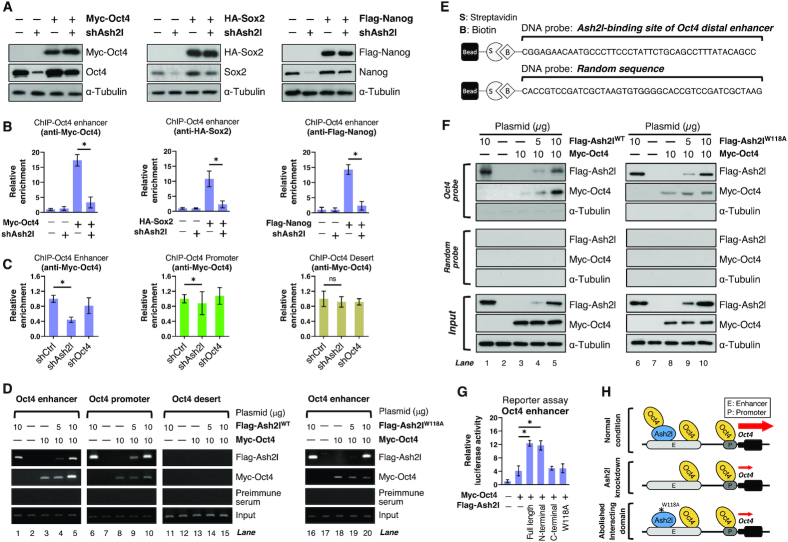Figure 6.
Ash2l recruits OSN to Oct4 super-enhancer to modulate Oct4 expression. (A) Western blot shows the restoration of endogenous Oct4, Sox2 and Nanog protein by exogenous introduction of Myc-tagged Oct4, HA-tagged Sox2 and Flag-tagged Nanog in ESCs with Ash2l knockdown. To examine the effect of Ash2l knockdown on OSN recruitment without affecting cellular protein content of Oct4, Sox2 and Nanog, Myc-tagged Oct4, HA-tagged Sox2 and Flag-tagged Nanog were exogenously introduced into ESCs with or without Ash2l knockdown. (B) ChIP-qPCR shows that the binding affinity of exogenously introduced Oct4 (left), Sox2 (middle) and Nanog (right) to the Oct4 enhancer in ESCs with or without Ash2l knockdown. Data were normalized with IgG control and shown as relative levels to that in shCtrl-transfected ESCs. (C) ChIP-qPCR reveals that Ash2l knockdown decreases Oct4 enrichment to Oct4 enhancer. Gene knockdown in ESCs was conducted with indicated lentivirus-based shRNA, followed by ChIP-qPCR analysis with specific antibodies. ChIP-qPCR shows that knockdown of Ash2l hampered Oct4 binding to the enhancer. Data were normalized with IgG control and presented as relative fold changes to the enrichment at enhancer in control ESCs. Data are presented as mean ± SD; *P< 0.01. (D) ChIP-RT-PCR analysis validates the regulatory effect of Ash2l on Oct4 binding ability to Oct4 enhancer. Flag-tagged Ash2l variants (Flag-Ash2lWT and Flag-Ash2lW118A) and Myc-tagged Oct4 were expressed in HEK293T cells. The amount of each transfected plasmid was indicated at the top. The nuclear extracts from the transfected HEK293T cells were purified and subjected to a ChIP-qPCR assay with indicated antibodies. The co-precipitated sequence of Oct4 enhancer and promoter were analyzed. Flag-Ash2lWT alone directly bound to Oct4 enhancer and promoter (lanes 1 and 6). Increasing amount of Flag-Ash2lWT enhanced Myc-Oct4 binding to Oct4 enhancer (lanes 4 and 5) but not to Oct4 promoter (lanes 9 and 10). Mutation of W118 position of Ash2l (Flag-Ash2lW118A) abrogated the Ash2l effect on Oct4 binding to enhancer (lanes 18–20). The pre-immune serum served as a negative control. (E) The design of DNA probes for Ash2l-binding site of Oct4 super-enhancer [-15k] and random sequence. (F) Validating the binding relationship between Ash2l and Oct4 at Oct4 super-enhancer by a DNA Affinity pull-down (DAPA) assay. The oligonucleotide probe containing Oct4 super-enhancer sequence was incubated with recombinant Ash2l and Oct4 proteins in vitro. The probe was precipitated and the co-precipitated Flag-Ash2l and Myc-Oct4 proteins were analyzed by western blot. Flag-Ash2lWT directly bound to Oct4 probe and enhanced the binding of recombinant Oct4 to Oct4 probe, whereas Flag-Ash2lW118A failed to exert the same effect. (G) A reporter plasmid containing the Oct4 enhancer sequence was transfected into HEK293T cells along with Oct4 and full-length (Ash2l-Full length), truncated (Ash2l-N terminus or Ash2l-C terminus) or mutated (Ash2lW118A) Ash2l expression plasmids. The luciferase activity representing Oct4 enhancer activity was assayed and shown as relative fold change to that of the empty vector-transfected cells. The Ash2l-Full length and Ash2l-N terminus enhanced Oct4 enhancer activity while Ash2l-C terminus and Ash2lW118A failed to increase Oct4 enhancer activity. (H) Illustrative scheme for the Ash2l-mediated Oct4 recruitment to Oct4 super-enhancer. The Ash2l-mediated Oct4 recruitment could be abrogated by Ash2l knockdown or the point mutation of W118A at Ash2l-N terminus. Data are presented as mean ± SD; *P< 0.01.

